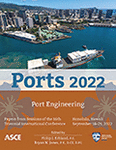Probabilistic Approach to Compute Extreme Value Loading on Vertical Wall Structures
Publication: Ports 2022
ABSTRACT
Wave loading for extreme events on vertical wall structures have traditionally being computed using the extreme values for water levels and wave heights derived from a single storm event (design storm method). Joint probability method-optimal sampling (JPM-OS) is a modern analysis method traditionally applied for storm surge modeling and uses a probabilistic framework to evaluate a range of possible variations in the storm conditions. Typically, this method is used to compute extremal hydraulic parameters such as water surface elevation or wave height, which can then be used to compute the wave loads (extreme value method). This study further extends and improvise on the use of the JPM-OS methodology to compute the 2% and 1% (50- and 100-year return period) annual exceedance probabilities (AEP) extreme values for hydrostatic and hydrodynamic loading on a vertical wall structure (probabilistic method). Storm surge modeling was conducted to simulate moving hurricane wind fields and generate the forcing conditions for loading analysis. Sensitivity testing was conducted to select a smaller suite of 63 representative storms to model from an available set of 446 synthetic storms used in the FEMA Flood Insurance Study for the project site. Multiple extraction points were placed on either side of each vertical wall structure in the model domain to record the water level and wave condition time series for each simulated storm event. Loading analysis was conducted for each set of extraction points on either side of the wall for every modeled storm event at each 30-min timestep using wave height, wave period, and water level time series from the storm-surge modeling results. The hydrostatic loads were derived from the head difference across the wall, while wave loads were computed using the Goda formulation for wave forces on a vertical wall. Extreme value analysis for the loads was performed by using Version 1.1 of FEMA’s SURGE_STAT program, which uses the maximum concurrent load and recurrence rates for each simulated storm. Using this software, the 1% and 2% AEP loads were determined at each extraction point. The results showed that the extreme value method, though common, is often over-conservative as it is unlikely that the extreme water level, wave height, and corresponding low water on the backside of the wall would occur concurrently. The design storm method is not able to capture the spatial variability of extreme conditions that may occur due to different storms (tracks and intensities) at different locations in the modeling domain as it uses a single storm event for analysis. This approach showed high variability in loads, with some storms showing higher than the probabilistic method loads, while others showed lower estimates. The advantage of using the probabilistic method for computing loads is that it considers the probabilistic nature of the storm events and therefore eliminates the over-conservatism of the extreme value method approach and the bias resulting from a design storm method approach.
Get full access to this article
View all available purchase options and get full access to this chapter.
REFERENCES
Dietrich, J. C., Zijlema, M., Westerink, J. J., Holthuijsen, L. H., Dawson, C. N., Luettich, R. A., Jr., Jensen, R. E., Smith, J. M., Stelling, G. S., and Stone, G. W. (2011). Modeling hurricane waves and storm surge using integrally-coupled, scalable computations. Coast. Eng. 58, 45–65.
FEMA. (2012). : Joint Probability - Optimal Sampling Method for Tropical Storm Surge Frequency Analysis. Washington, DC: US Department of Homeland Security.
Goda, Y. (2010). Reanalysis of Regular and Random Breaking Wave Statistics, Coastal Engineering Journal, 52:1, 71–106.
Ho, F. A. (1975). Joint Probability Method of Tide Frequency Analysis applied to Apalachicola Bay and St. George Sound, Florida.
Luettich, R., and Westerink, J. (2006). ADCIRC: A (parallel) advanced circulation model for oceanic, coastal and estuarine waters. User Manual V47.11.
Resio, D. (2007). White Paper on Estimating Hurricane Inundation Probabilities (with contributions from S.J. Boc, L. Borgman, V. Cardone, A. Cox, W.R. Dally, R.G. Dean, D. Divoky, E. Hirsh, J.L. Irish, D. Levinson, A. Niedoroda, M.D. Powell, J.J. Ratcliff, V Stutts).
USACE. (2002). Coastal engineering manual. Engineer Manual, 1110, 2–1100.
USACE. (2008a). Flood Insurance Study: Southeastern Parishes, Louisiana. New Orleans District, Mississippi Valley Division. July.
USACE. (2008b). Flood Insurance Study: Southwestern Parishes, Louisiana. New Orleans District, Mississippi Valley Division. October.
Willmott, C. J., Ackleson, S. G., Davis, R. E., Feddema, J. J., Klink, K. M., Legates, D. R., O’Donnell, J., and Rowe, C. M. (1985). Statistics for the evaluation and comparison of models. J. Geophys. Res. 90 (c5), 8995e9005.
Information & Authors
Information
Published In
History
Published online: Sep 15, 2022
Authors
Metrics & Citations
Metrics
Citations
Download citation
If you have the appropriate software installed, you can download article citation data to the citation manager of your choice. Simply select your manager software from the list below and click Download.
